
p.6 EDITORIAL
[author : Jonathan Erickson] #Edito
TABLE OF CONTENTS
FEATURES
p.16 THE FAST WAVELET TRANSFORM
[author : Mac A. Cody]
Fast wavelet transformations pick up where fast Fourier transforms leave off.
p.32 YOUR OWN HANDPRINTING RECOGNITION ENGINE
[author : Ron Avitzur]
Ron discusses the design and implementation of a writer-dependent, platform-independent recognition engine for handprinted text.
p.42 RED-BLACK TREES
[author : Bruce Schneier]
The red-black algorithm, a twist on the classic binary search tree, uses an efficient mechanism for balancing trees.
p.48 BLOCK TRUNCATION COMPRESSION
[author : Anton Kruger]
BTC preserves image statistics, resulting in compressed images requiring 75 percent less disk space.
p.56 FINDING STRING DISTANCES
[author : Ray Valdes]
Precise sequence comparisons are basic to molecular biology research and handwriting recognition.
p.64 PORTING UNIX TO THE 386: DEVICE DRIVERS
[author : William Frederick Jolitz and Lynne Greer Jolitz]
Our discussion of 386 BSD device drivers continues, focusing on interrupt routines.
EMBEDDED SYSTEMS
p.70 MULTIUSER DOS FOR CONTROL SYSTEMS: PART I
[author : Richard Kryszak]
Multiuser DOS from Digital Research is an MS-DOS compatible, multitasking operating system that's a good platform for control systems.
EXAMINING ROOM
p.80 WINDOWS PROGRAMMING WITH BASIC
[author : Raymond J. Schneider]
Ray shows how mathematical chaos works by graphically exploring Lorenz equations.
PROGRAMMER'S WORKBENCH
p.86 THE DESIGN OF THE MATHEMATICA PROGRAMMING LANGUAGE
[author : Roman E. Maeder]
The rule-based paradigm in Mathematica's programming language lets you write code that closely matches the formulation of the problem to be solved.
COLUMNS
p.115 PROGRAMMING PARADIGMS
[author : Michael Swaine]
Michael examines the life of Ada Lovelace and ponders whether programming is an art or a science.
p.121 C PROGRAMMING
[author : Al Stevens]
Menus are added to D-Flat in this month's installment.
p.131 STRUCTURED PROGRAMMING
[author : Jeff Duntemann]
Jeff continues his exploration of Turbo Vision, focusing on how Turbo Pascal handles collections.
p.139 GRAPHICS PROGRAMMING
[author : Michael Abrash]
Raw speed and hidden surfaces are Michael's topics this month.
p.145 PROGRAMMER'S BOOKSHELF
[author : Andrew Schulman]
Andrew makes the case that the best programming books are written by and for programmers.
DEPARTMENTS
p.8 LETTERS
[author : you]
p.168 SWAINE'S FLAMES
[author : Michael Swaine]
PROGRAMMER'S SERVICES
p.160 OF INTEREST
[author : Tami Zemel]
